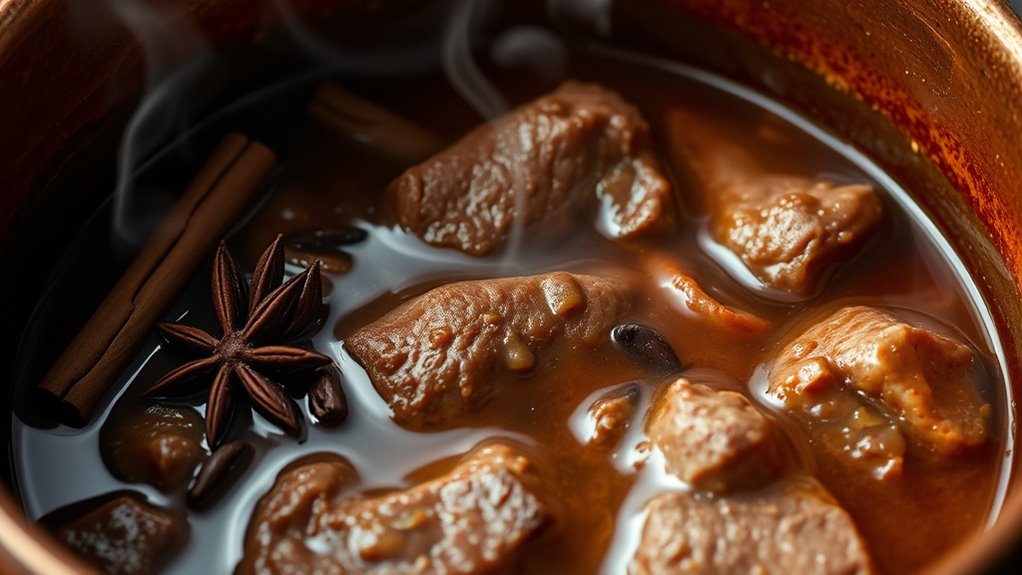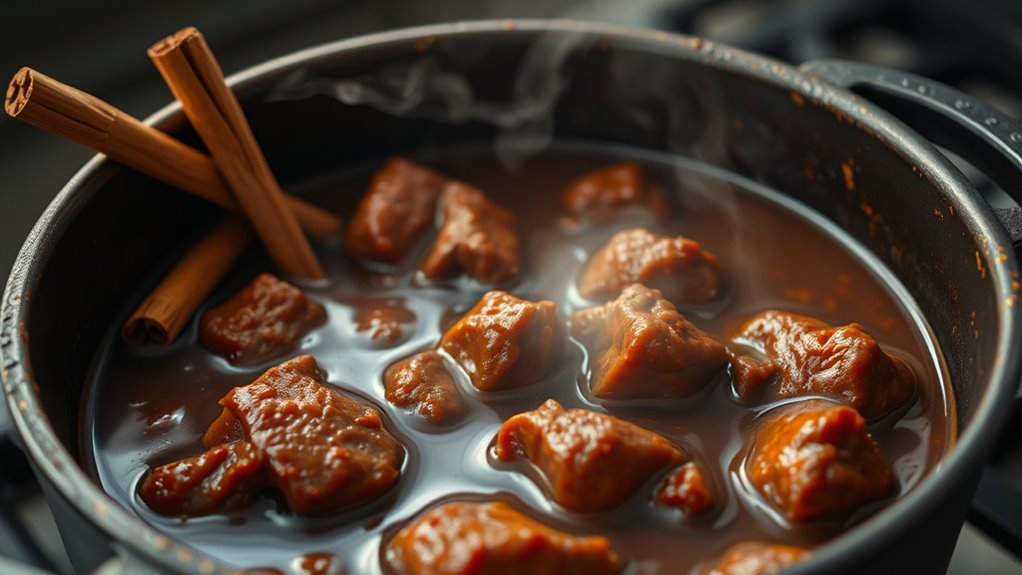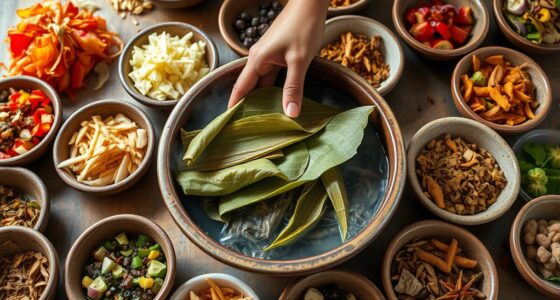To open rendang’s rich flavor, your focus should be on slow simmering with precise control. Start by blending spices into a fragrant paste, then gently cook it until aromatic. Add beef and coconut milk, maintaining a steady, low heat to allow the flavors to deepen over several hours. Stir occasionally to prevent sticking and guarantee even cooking. Mastering this delicate process reveals the authentic taste, and if you keep exploring, you’ll discover even more culinary secrets.
Key Takeaways
- Master the proper spice paste blending to create a flavorful base essential for authentic rendang.
- Maintain a gentle, consistent simmer over several hours to allow flavors to deepen and meat to tenderize.
- Control temperature carefully to prevent burning and over-reduction, ensuring a rich, thick sauce.
- Stir occasionally during simmering to promote even cooking and prevent sticking or burning.
- Understand the cultural significance of patience and technique, reflecting traditional craftsmanship in every step.

Rendang is more than just a flavorful dish; it’s a culinary masterpiece rooted in rich traditions and secret techniques. When you immerse yourself in making rendang, you’re engaging with a dish that carries deep cultural significance, especially in Indonesia and Malaysia. This dish isn’t just about tasty ingredients; it’s a symbol of heritage, community, and celebration. The slow simmering process plays a crucial role in preserving its cultural importance, as it embodies patience, respect for tradition, and the artistry passed down through generations. As you prepare rendang, you’re participating in a culinary ritual that links the past with the present, honoring ancestral methods and cultural values.
The secret to revealing the true essence of rendang lies in mastering its cooking techniques. Unlike quick-fix recipes, rendang demands a slow, meticulous simmer that takes several hours. This slow cooking allows the flavors to deepen and meld, transforming humble ingredients into a complex, aromatic masterpiece. You start by blending a rich spice paste, often including turmeric, ginger, garlic, and chili, which forms the flavor foundation. Once the spice mixture is cooked until fragrant, you add chunks of beef, coconut milk, and other seasonings. The key is to maintain a gentle simmer, stirring occasionally, ensuring the sauce reduces gradually. This process not only tenderizes the meat but also helps the spices fully infuse, creating that signature depth of flavor. Proper temperature control is crucial during this process to prevent burning or over-reduction.
Throughout the simmering process, you must pay close attention to temperature and moisture levels. Too high a heat can cause the spices to burn or the sauce to evaporate too quickly, compromising the dish’s texture and flavor. Conversely, too low a heat prolongs cooking time unnecessarily. The skill lies in balancing these elements so that the liquid reduces slowly, forming a thick, sticky coating around the meat. This technique develops the rich, caramelized notes characteristic of authentic rendang. The longer you cook, the more the flavors concentrate, making the dish intensely aromatic and flavorful.
In essence, mastering rendang’s slow simmer isn’t just about following a recipe; it’s about understanding the delicate dance of heat, patience, and technique. Each step, rooted in tradition, contributes to the dish’s cultural significance—an edible reflection of history and craftsmanship. When you finally serve rendang, you’re not just offering a meal but sharing a piece of cultural heritage, created through time-honored cooking techniques that elevate simple ingredients into a culinary work of art.
Frequently Asked Questions
Can Rendang Be Cooked Quickly Without Losing Flavor?
You wonder if rendang can be cooked quickly without losing flavor. While traditional slow simmering enhances its rich taste, quick cooking can still preserve flavor if you use high heat carefully and keep the ingredients well-coated with spices. To achieve this, blend spices thoroughly and cook at a controlled pace, stirring often. Although it won’t develop the same depth, these tips help you enjoy flavorful rendang in less time.
What Are the Key Spices That Define Rendang’s Taste?
Imagine capturing the essence of rendang in just a few spices—that’s the magic of its signature flavor profile. You’ll find key spice blends like turmeric, lemongrass, ginger, and galangal, each adding depth. Don’t forget the aromatic layers of shallots, garlic, and chili. These spices combine to create a complex, rich taste that defines rendang, making it unforgettable. Mastering these spice blends is your key to authentic flavor.
How Does the Slow Simmer Affect Meat Tenderness?
You’ll find that the slow simmer considerably improves meat texture by breaking down connective tissues, making the meat tender and flavorful. The extended cooking duration allows heat to penetrate evenly, ensuring every piece of meat becomes soft and juicy. As you continue simmering, the meat absorbs spices better, enhancing taste while achieving a melt-in-your-mouth consistency. This slow process transforms tough cuts into a delicious, tender dish you’ll enjoy every time.
Can Rendang Be Made Vegetarian or Vegan?
Imagine you’re in a time machine, changing a classic dish. Yes, you can make rendang vegetarian or vegan! Use vegetarian alternatives like tofu or tempeh, and vegan substitutions for traditional spices and coconut milk. These options let you enjoy the rich flavors and texture, even without meat. With a little creativity, you’ll craft a delicious, plant-based rendang that’s just as satisfying as the original.
What Are Traditional Serving Accompaniments for Rendang?
You’ll find traditional side dishes like steamed rice to be the perfect rice accompaniments for rendang, soaking up its rich, spicy flavors. Some also enjoy serving rendang with nasi lemak or jasmine rice for added aroma. These rice accompaniments balance the intense, savory notes of the rendang, making each bite more satisfying. Classic accompaniments truly enhance your experience, highlighting the dish’s deep, complex flavors.
Conclusion
Now that you know the magic behind rendang’s slow simmer, you hold the key to revealing its rich, complex flavors. Remember, patience isn’t just a virtue here—it’s the secret ingredient that transforms humble ingredients into a culinary masterpiece. So, next time you cook rendang, embrace the wait and let time work its wonders. After all, isn’t the best flavor worth every slow, savory second? Your perfect rendang awaits.









